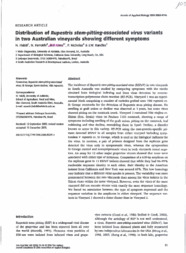Distribution of Rupestris stem-pitting-associated virus variants in two Australian vineyards showing different symptoms.
Distribution of Rupestris stem-pitting-associated virus variants in two Australian vineyards showing different symptoms.
Author(s): HABILI, N.; FARROKHI, N.; LIMA, M. F.; NICHOLAS, P.; RANDLES, J. M.
Summary: The incidence of Rupestris stem-pittinq-assodated virus (RSPaV) in two vineyards in South Australia was studied by comparing symptoms with the results obtained Irom biological indexing and from virus detection by reversetranscription-polymerase chain reaction (RT-PCR). Vineyard 1 was an experimentalblock comprising a number of varieties grafted onto Vitis rupestris cv. SI George rootstocks for the detection of Rupestris stem pitting disease. No sweUing ar graft union or decline was observed at 3 years, but some vines showed pitting on the rootstock trunk. Vineyard 2 contained Vitis vim/era cv. Shiraz (Syn. Syrah) vines on Paulsen 1103 rootstock, showing a range of symptoms induding swelling of the graft union, pitting on the rootstock, leaf reddening and vine decline, resembling those in Syrah Decline, a disorder known to occur in this variety. RT-PCR using the coat-protein-specific primers detected RSPaV in ali samples from either vineyard including symptomIess V. rupesttis cv. St George, which is used as the biological indicator for the virus. In contrast, a pair of primers designed from the replicase gene detected the vírus only in symptomatic vines, whereas the symptomIess St George control and nonsymptomatic vines in both vineyards tested negative. An assay for 12 other major grapevine viruses showed that none were assodated with eíther lype of symprorn, Comparison of a 628-bp amplicon on the replicase gene in 13 RSPaV isolates showed that while they had 96-99% nudeotide sequence identity to each other, their identity to the American isolates from California and New York was around 65%. This low homology may indicate that a different virus species is present. The variability was more pronounced between the two vineyards than among the vírus isolates in the Shiraz vines within the same vineyard. However, even the vines of the same vineyard did not contain viruses with exactly the same sequence homology. We found no association between the type of symptom expressed and the sequence variation in the amplicons in either vineyard. The sequence varo iants in Vineyard 1 showed a doser cluster than in Vineyard 2.
Publication year: 2006
Types of publication: Journal article
Unit: Embrapa Semi-arid Region
Observation
Some of Embrapa's publications are published as ePub files. To read them, use or download one of the following free software options to your computer or mobile device. Android: Google Play Books; IOS: iBooks; Windows and Linux: Calibre.
Access other publications
Access the Agricultural Research Database (BDPA) to consult Embrapa's full library collection and records.
Visit Embrapa Bookstore to purchase books and other publications sold by Embrapa.

